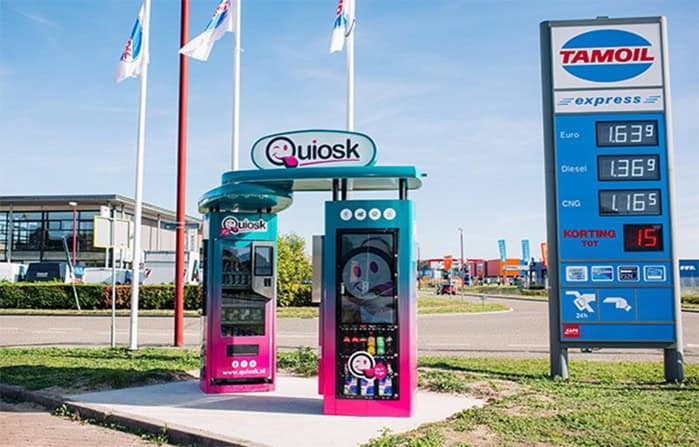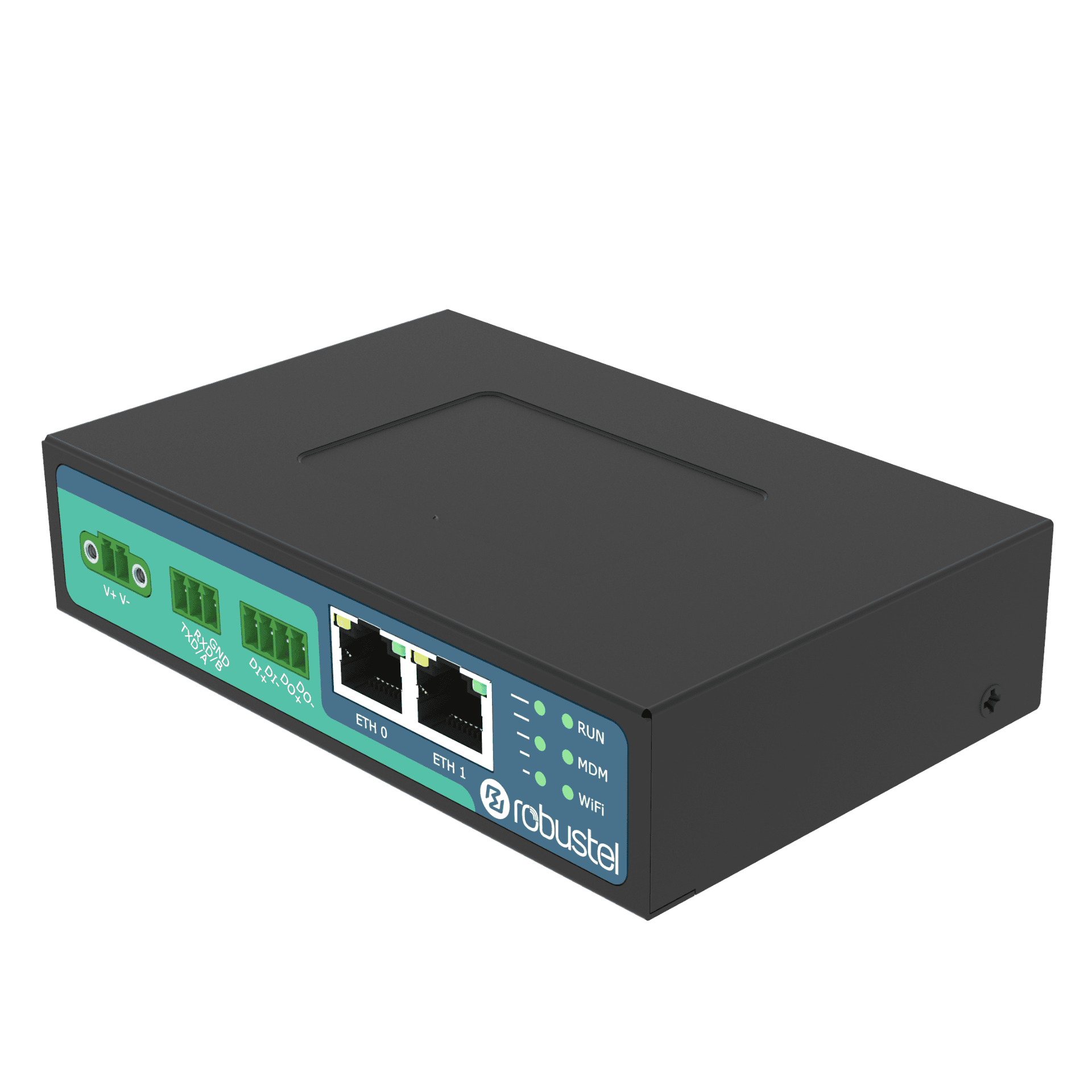Reliable Connectivity for Unattended Vending Kiosks:
How Robustel & Quiosk use the R2010 to stay online, process cashless payments, and report stock levels
Case Study – Fast Facts
Location
Netherlands
Industry
Retail & Payments, Vending, Smart Cities
Product(s)
- R2010
- RCMS
End Customer
Quiosk – https://www.quiosk.nl/
Quiosk operates self-service vending machines and kiosks in public locations such as stations, shopping areas, and transport hubs. Their machines sell items without staff on site and depend on card payments and back-office systems to work smoothly. Uptime is essential for revenue and for keeping site owners happy. The company faces pressure to keep machines connected, secure, and easy to service as the network grows.
Challenges
Quiosk needed a single connectivity solution that would work across many types of location, from indoor malls to outdoor sites, without depending on local Wi-Fi or cabling. They had to support reliable payment authorisation, remote stock reporting, and central control for hundreds of vending machines, while keeping on-site visits to a minimum. At the same time, they wanted a way to monitor the entire installed base and act quickly when a machine went offline, without sending engineers blind into the field.
Results
With the R2010 and RCMS, each kiosk now has its own industrial-grade cellular connection, directly controlled by Quiosk. Machines stay connected for payment, telemetry, and remote management, and the operations team can see the status of every router from a single dashboard. Faults are easier to diagnose remotely, engineer visits are better targeted, and the business can deploy new locations with a repeatable, trusted template.
Connecting unmanned kiosks without relying on local networks
Quiosk’s business depends on being able to place vending machines wherever footfall is high and permits allow. That includes railway stations, office lobbies, campuses, and street locations where the company cannot assume access to a stable local network. In many cases, the site owner either cannot or will not provide a dedicated line to each kiosk, and public Wi-Fi is not acceptable for payment traffic. This made connectivity a constant negotiation and a technical risk for every new deal.
As the fleet grew, the operations team also needed better visibility. When a machine stopped taking payments or reporting stock, it was not always clear if the problem was the device, the network, or the upstream systems. Sending engineers to check on site was expensive and slow. Quiosk wanted a connectivity platform that they controlled end-to-end, with a cloud view of every kiosk and tools to keep the fleet running with a small central team.
Business Challenges
1. Dependence on site-provided networks
Many vending locations offered no dedicated network connection for kiosks, or only provided access under strict conditions. In some buildings, IT teams were unwilling to connect third-party machines to their internal networks. In others, public or guest networks were available but not suitable for payment terminals and vending controllers. This meant that each site required individual negotiation and bespoke workarounds, slowing down deployment and adding uncertainty.
Operationally, that network dependence created ongoing risk. If a building changed network policies, moved equipment, or experienced local outages, kiosks could lose connectivity without warning. Payment failures not only meant lost revenue but also damaged trust with landlords and customers. Quiosk needed a way to take the network problem off the table by bringing its own secure, independent connectivity to each machine.
2. Limited visibility into machine status and connectivity
When a vending machine stopped selling or went offline, the central team had only partial information. Was the payment terminal down, was the controller stuck, or had the network connection failed? Without clear visibility into the router and link, many incidents turned into site visits just to understand the root cause.
This lack of insight made planning and scheduling difficult. Engineers could arrive on site only to find that the machine had recovered or that the issue lay with the upstream system rather than the endpoint. Over time, this increased the cost to serve each kiosk, stretched the technical team, and slowed the pace at which the fleet could grow.
3. Scaling a consistent architecture across hundreds of kiosks
As Quiosk expanded, variation in hardware and configuration between machines became a problem. Different connectivity devices, firmware versions, and setup methods made it harder to maintain standards. Documentation had to cover many permutations, and small misconfigurations at install time could lead to support calls months later.
From a business perspective, this lack of standardisation limited scale. Every new project risked becoming a special case, and the time needed for design, testing, and approval increased. Quiosk wanted a single, stable hardware and configuration pattern they could use across sites, so installers knew exactly what to fit, and the central team knew exactly how to support it.
Solution Overview

Quiosk chose the Robustel R2010 as the embedded connectivity platform for its vending machines, combined with RCMS for cloud-based fleet management. In each kiosk, the R2010 sits inside the cabinet, connected via Ethernet to the vending controller and, where applicable, to payment terminals or local devices. A cellular SIM provides 4G/LTE backhaul so the machine can communicate directly with Quiosk’s back-end systems for payment authorisation, stock reporting, and remote updates, without touching the site owner’s network.
From a central operations perspective, RCMS provides a live view of the installed base. Each R2010 reports its status, signal quality, and data usage to the cloud. The team can group devices by customer, region, or machine type, apply configuration templates, and push firmware updates without visiting sites. When a problem occurs, they can see whether the router is online, whether the cellular link is healthy, and whether the issue is likely to be local or upstream, allowing them to triage before dispatching an engineer.
Why Quiosk chose the R2010
- Industrial form factor for kiosk environments: The R2010 is built to run inside vending cabinets, with suitable power input, mounting options, and environmental resilience. It copes well with the temperature and electrical noise found in vending locations, from quiet offices to busy transport hubs.
- Dependable cellular backhaul: With 4G/LTE connectivity, the R2010 gives each kiosk its own independent path to the cloud. Quiosk no longer needs to rely on customer-supplied networks, which simplifies negotiations and improves predictability across sites.
- Simple integration with vending controllers: Multiple Ethernet ports and standard IP routing make it easy to connect the R2010 to vending controllers and payment systems without redesigning existing electronics. The router focuses on networking, leaving machine logic unchanged.
- Fleet management with RCMS: RCMS lets Quiosk monitor all deployed routers from one interface, apply configuration templates, and perform remote diagnostics. This reduces manual configuration, supports consistent rollouts, and helps the team spot emerging issues before they affect sales.
- Security controls aligned with payment needs: Built-in firewalling and VPN options allow traffic to be restricted and encrypted as required, helping meet the expectations of payment providers and site owners around how transaction data is handled in transit.
Key Outcomes
By adopting a standard connectivity platform, Quiosk turned connectivity from a variable on each contract into a known part of their service. Machines now reach the cloud over a path they control, and the central team has tools to keep the fleet healthy as it grows.
- Higher kiosk uptime: Machines are far less likely to be out of service due to network issues, which protects revenue and keeps locations attractive for landlords.
- Fewer blind site visits: With clear router and link status in RCMS, many issues can be understood or resolved remotely. When an engineer does need to go on site, they arrive with a clear idea of what to check.
- Consistent architecture across the fleet: New kiosks follow the same pattern for connectivity and management, reducing installation variability and simplifying documentation, training, and support.
- Faster deployment of new locations: Because connectivity is handled by the R2010 and not dependent on local infrastructure, new sites can be brought online more quickly, supporting business growth and new commercial opportunities.
- Better control of operating costs: Remote management, clearer diagnostics, and fewer surprises in the field help Quiosk control the cost of supporting each machine, even as the number of deployed kiosks increases.
Featured Products
Robustel R2010 4G/LTE Router

RCMS Cloud Device Management

